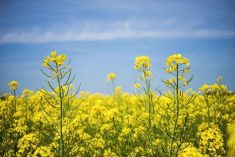When powdery scab appears, it creates a frustrating problem for potato producers with both a lack of above-ground symptoms and its status as the only known vector of the potato mop-top virus.
Amy Charkowski, a professor of plant pathology and research associate dean at Colorado State University, spoke to an audience at Manitoba Potato Production Days in Brandon in late January about the disease and the challenges it presents.
“It’s different from a lot of soil-based pathogens,” Charkowski says.
Read Also

Journal pulls long-cited glyphosate study for ethics violations
The journal Regulatory Toxicology and Pharmacology has retracted a 2000 Monsanto-linked glyphosate review, drawing new scrutiny as Bayer faces mounting legal pressure.
WHY IT MATTERS: Manitoba’s next potato crop is about to go into the ground.
Powdery scab, caused by Spongospora subterranea, thrives in cool, moist conditions and can significantly impact potato crops by forming lesions on tubers and galls on roots.
Tubers infected with powdery scab initially show purplish-brown, sunken lesions on tubers, followed by brown, raised pustules filled with spores. According to Ontario’s provincial agriculture website, powdery scab lesions can look remarkably similar to common scab. Pustules can enlarge up to five millimetres in diameter, and as they mature, the pustules release spores.
Small necrotic spots develop into white galls from one to 10 mm in diameter on roots and stolons. These galls turn a dark brown upon maturity, and then slowly break down, releasing powdery spores into soil, where they can survive for many years as resting spores.
Powdery scab attacks roots, stolons, young shoots and tubers, and is spread by planting infected seed tubers, moving infested soil or spreading contaminated cattle manure.
As potato roots grow, they stimulate resting spores to germinate, which release swimming spores that attack roots, root hairs, stolons, young shoots or tubers. Galls are formed, and a fungal mass grows inside infected tissue and releases secondary swimming spores, which further spread the disease. With ideal conditions, several generations of secondary spores are then produced and release, continuing the problem.
A recipe for powdery scab
Despite its favourite conditions, powdery scab can still develop in warm, dry weather, in low-lying or shaded areas of fields that have heavy spore infestation.
However, powdery scab has a weak spot in the swimming spore, Charkowski says.
“Swimming spores don’t last very long. That’s an area that some researchers are working on, trying to understand if they can make these spores germinate without the potatoes around.”
While powdery scab does not spread in storage, its lesions can lead to secondary issues, making tubers more difficult to store and market. In addition, it can transmit potato mop-top virus (PMTV), which affects tuber quality and can cause symptoms such as spraing.
However, visible foliar symptoms of PMTV are rare, Charkowski says. “I’ve seen it two times, once in the field…and then once in our greenhouse.”
Managing powdery scab
To check for powdery scab, the province of Ontario recommends digging up tubers at random from mid- to late season, especially in low spots and spots with poor drainage.
Powdery scab is a disease that’s particularly difficult to study, Charkowski says. “We can’t grow it without the plant being present…it makes it much harder to study in a lab.”
In Charkowski’s research in south-central Colorado’s San Luis Valley, soil inoculum levels vary widely across farms, and factors such as irrigation practices influence disease severity.
Crop rotation alone is not a sufficient solution, as the pathogen remains in soil for extended periods.
“We’ve tried, I think, 18 or 19 different rotation crops,” Charkowski says.
Her research also revealed challenges in seed potato production. Powdery scab can persist in greenhouse potting mixes. Heat treatment of soil, a common sterilization method, unexpectedly worsened the issue by eliminating beneficial microbes such as trichoderma, which may help suppress the disease.
“When we looked at the literature, we saw that indeed, trichoderma in greenhouse experiments has been shown to provide some control over some of those for us, and so we’re trialing this right now in the field in Colorado.”
While there is an overlap between pathogen, susceptible plant and environment to create the disease, that can prove useful to researchers and producers.
“If you can reduce that overlap, you can reduce the disease,” Charkowski says.
A team in the U.S. is also developing rapid diagnostic tools for detecting viruses, including PMTV. The goal is to streamline sample processing and improve early detection.
“We have trained people who work at Colorado Parks how to do this, but as you know, finding labour in the fall is really hard. That’s still an issue,” Charkowski says.
Managing powdery scab requires an integrated approach. Using certified clean seed, monitoring soil inoculum levels, adjusting irrigation practices, and selecting resistant varieties can help mitigate the disease’s impact.
“It’s worth really understanding your local varieties and how they increase soil inoculum, so that you at least are not making the problem worse,” Charkowski says.
Biosecurity is always important when talking about diseases, including powdery scab, Charkowski says. In addition to planting powdery scab-free seed, the Ontario agriculture department suggests producers abstain from using manure from farm animals that have eaten potatoes infected with powdery scab.
It’s also a good idea to avoid moving farm equipment from contaminated fields to healthy ones.
“I fully understand how difficult this is,” Charkowski told the producers at Manitoba Potato Days. “Thinking about biosecurity and sanitation is going to help you with many, many diseases.”















